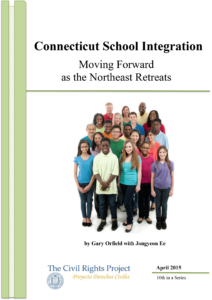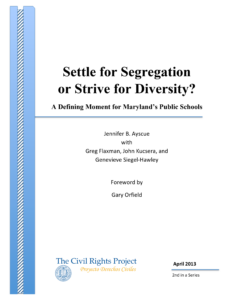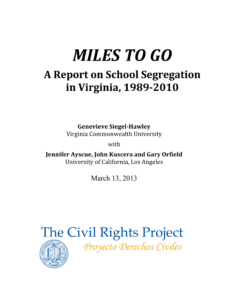Foreword
In a country where more than half of the public school students are nonwhite and segregation of schools has been severe and rising for decades, Northern New England is an outlier, still an overwhelmingly white area with so few students of color in most areas that segregation in schools is virtually impossible on any scale. This is much like the pattern of Southern New England at the time of the Brown decision, a pattern that is now dramatically different. We are looking systematically at the entire East Coast from Maine through North Carolina and are finding that the Northern New England states are the only ones that have not been very substantially affected by the massive changes in the country’s demography and immigration patterns. One major cause has been the slow population growth of the region which has forestalled the demand for labor, which often precipitates increased diversity, since a very large share of those now entering the nation’s labor market are nonwhite. As the region recovers from the Great Recession these changes may well accelerate.
Southern New Hampshire and Vermont and nearby parts of Maine are, of course, affected by the trends in metropolitan Boston since the economic and social ties are strong. Our Massachusetts study shows that Eastern Massachusetts has not handled these issues effectively and constitutes a warning to the nearby states. Other growing metros in Northern New England also show early signs of significant diversification.
In addition to some early signs of segregation, which should be attended to before they become serious challenges, we want to call attention to something we rarely find in other parts of the country—significant areas of concentrated white poverty in schools. Concentrated, persistent poverty, regardless of race, creates very serious challenges to schools. To the extent that boundary changes, choice and magnet plans, and other techniques can be used to create integration across the lines of poverty, they can provide significant social and educational benefits. These issues deserve our attention.
Our reports are, in a way, check-ups on the status of racial and ethnic equity. In contrast to a number of the states we are examining, Northern New England has, in general, modest and solvable challenges. This is a very good time for the educational leaders and municipal authorities of the region to plan to act promptly and avoid the intensifying challenges that many eastern states have failed to address, to their considerable cost. As a long-time resident of greater Boston, who conducted many studies of the area in my years on the Harvard faculty, I know well that Northern New England is a beautiful and special place. I would love to see it break the mold of resegregation and deepening inequality in the years to come.
–Gary Orfield
This report is part of a special series, “School Segregation Trends in the Eastern States.” Other reports in this series can be found below. These studies explore trends in enrollment and school segregation patterns from 1989 to 2010 at the state and regional levels, including various metro areas for each state. The reports also document the history of school desegregation in each state and across its geographic regions, including key desegregation cases and remedies, when applicable.
In compliance with the UC Open Access Policy, this report has been made available on eScholarship:
http://escholarship.org/uc/item/33n1827g










